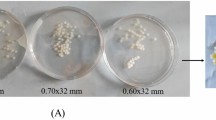Abstract
A series of silica-supported macroporous chitosan membranes (CM15, CM20, and CM25) was prepared by varying the ratio of 70–230-μm-sized silica particles. These synthesized membranes were further cross-linked using different cross-linking agents for covalent immobilization of biological macromolecules especially enzymes and in this study, Bovine serum albumin and laccase. Effects of silica particle and cross-linking agents on their flow rates, surface properties, and chemical and biological properties were explored. Pore size of as-synthesized membranes was 0.1192, 0.1268, and 0.1623 μm, respectively, for CM15, CM20, and CM25. The effect of various parameters such as temperature and pH on the relative activity of both free and immobilized enzymes was studied in details. The relative enzyme activity upon immobilization was greatly enhanced several folds of its original activity. The stability of enzymes over a range of temperature and pH was significantly improved by immobilization. The optimum temperature and pH were determined to be 50 °C and pH 3, respectively, for both the free and the immobilized enzymes. The immobilized enzyme possessed good operational stability and reusability properties that support its potentiality for practical applications. Among three membranes, CM25 is confirmed to be efficient candidate due to its improved characteristics.






Similar content being viewed by others
References
Anjali Devi D, Smitha B, Sridhar A, Aminabhavi TM (2005) Pervaporation separation of isopropanol/water mixtures through crosslinked chitosan membranes. J Membr Sci 262:91–99
Bautista FM, Bravo MC, Campelo JM, Garcia A, Luna D, Marinas JM, Romero AA (1999) Covalent immobilization of acid phosphatase on amorphous AlPO4 support. J Mol Catal B 6:473–481
Beppu MM, Arruda EJ, Vieira RS, Santos NN (2004) Adsorption of Cu(II) on porous chitosan membranes functionalized with histidine. J Membr Sci 240:227–235
Cabana H, Jones JP, Agathos SN (2007) Preparation and characterization of cross-linked laccase aggregates and their application to the elimination of endocrine disrupting chemicals. J Biotechnol 132:23–31
Chen P-H, Hwang Y-H, Kuo T-Y, Liu F-H, Lai J-H, Hsieh H-J (2007) Improvement in the properties of chitosan membranes using natural organic acid solutions as solvents for chitisan dissolutions. J Med Biol Eng 27:23–28
de Oliveira PC, Alves GM, de Castro HF (2000) Immobilisation studies and catalytic properties of microbial lipase onto styrene-divinylbenzene copolymer. Biochem Eng J 5:63–71
Hu Q-L, Fang Z-P, Zhao Y, Xu C-W (2001) A new method to prepare chitosan membrane as a biomedical material. Chin J Polym Sci 5:467–470
Iwata H, Saito K, Furusaki S (1991) Adsorption characteristics of an immobilized metal affinity membrane. Biotechnol Prog 7:412–418
Kim JY, Lee JK, Lee TS, Park WH (2003) Synthesis of chitooligosaccharide derivative with quaternary ammonium group and its antimicrobial activity against Streptococcus mutans. Int J Biol Macromol 32:23–27
Liu CG, Chen XG, Park HJ (2005) Self assembled nanoparticles based on linoleic-acid modified chitosan: stability and adsorption of trypsin. Carbohydr Polym 62:293–298
Madihally SV, Matthew HWT (1999) Porous chitosan sca!olds for tissue engineering. Biomaterials 20:1133–1142
Malmiri HJ, Jahanian MAG, Berenjian A (2012) Potential applications of chitosan nanoparticles as novel support in enzyme immobilization. Am J Biochem Biotechnol 8:203–219
Manjubala I, Scheler S, Bössert J, Jandt KD (2006) Mineralisation of chitosan scaffolds with nano-apatite formation by double diffusion technique. Acta Biomater 2:75–84
Oh J-T, Kim J-H (2000) Preparation and properties of immobilized amyloglucosidase on nonporous PS/PNaSS microspheres. Enzyme Microbiol Technol 27:356–361
Sh. Rashidova S, Sh. Shakarova D, Ruzimuradov ON, Satubaldieva DT, Zalyalieva SV, Shpigun OA, Varlamov VP, Kabulov BD (2004) Bionanocompositional chitosan-silica sorbent for liquid chromatography. J Chromatogr B 800:49–53
Ruckenstein E, Zeng XF (1998) Albumin separation with cibacron blue carrying macroporous chitosan and chitin affinity membranes. J Membr Sci 142:13–26
Susanto H, Samsudin AM, Rokhati N, Widiasa IN (2013) Immobilization of glucose oxidase on chitosan-based porous composite membranes and their potential use in biosensors. Enzyme Microbial Technol 52:386–392
Tang ZX, Qian JQ, Shi LE (2006) Characterizations of immobilized neutral proteinase on chitosan nano-particles. Process Biochem 41:1193–1197
Wei YC, Hudson SM, Mayer JM, Kaplan DL (1992) The crosslinking of chitosan fibers. J Polym Sci Part A 30:2187–2193
Yang W-Y, Thirumavalavan M, Malini M, Annadurai G, Lee J-F (2014) Development of silica gel-supported modified macroporous chitosan membranes for enzyme immobilization and their characterization analyses. J Membr Biol 247:549–559
Zakaria Z, Izzah Z, Jawaid M, Hassan A (2012) Effect of degree of deacetylation of chitosan on thermal stability and compatibility of chitosan-polyamide blend. Bioresources 7:5568–5580
Zeng XF, Ruckenstein E (1996a) Supported chitosan-dye affinity membranes and their adsorption of protein. J Membr Sci 117:271–278
Zeng XF, Ruckenstein E (1996b) Control of pore sizes in macroporous chitosan and chitin membranes. Ind Eng Chem Res 35:4169–4175
Zhang L, Zhua X, Zhenga S, Sunb H (2009) Photochemical preparation of magnetic chitosan beads for immobilization of pullulanase. Biochem Eng J 46:83–87
Acknowledgments
We thank the National Central University and National Science Council (NSC, (Grant No.: NSC100-2923-E-008-001-MY3), Taiwan, Republic of China (ROC) for financial support.
Author information
Authors and Affiliations
Corresponding authors
Rights and permissions
About this article
Cite this article
Yang, WY., Thirumavalavan, M. & Lee, JF. Effects of Porogen and Cross-Linking Agents on Improved Properties of Silica-Supported Macroporous Chitosan Membranes for Enzyme Immobilization. J Membrane Biol 248, 231–240 (2015). https://doi.org/10.1007/s00232-014-9763-8
Received:
Accepted:
Published:
Issue Date:
DOI: https://doi.org/10.1007/s00232-014-9763-8




